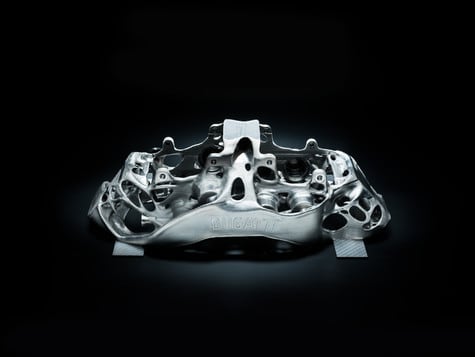
(Credit: Bugatti)
According to Bugatti, the eight-piston monobloc brake caliper is also the world’s first to be produced using a 3D printer, and the largest brake caliper in the automotive industry as a whole. Coming in at just 2.9kg, the component marks a 40 per cent weight saving on the 4.9kg aluminium caliper Bugatti currently uses on its Chiron supercar.
“In terms of volume, this is the largest functional component produced from titanium by additive manufacturing methods,” said Frank Götzke, head of New Technologies in Bugatti’s Technical Development Department. “Everyone who looks at the part is surprised at how light it is – despite its large size. Technically, this is an extremely impressive brake caliper, and it also looks great.”
The component was produced in collaboration with Laser Zentrum Nord of Hamburg, a recent addition to Germany’s Fraunhofer research organisation. Over a period of 45 hours, four 400-watt lasers deposited 2,213 layers of titanium alloy Ti6AI4V to create the caliper, which is then heat-treated in a furnace at temperatures that start at 700°C and fall to 100°C. The supporting structures were then removed and the component separated from the tray.

Frank Götzke (Credit: Bugatti)
At the next stage, the surface was smoothed in a combined mechanical, physical and chemical process which significantly improves the fatigue strength. Finally, the contours of functional surfaces, such as the piston contact surfaces or threads, were machined in a five-axis milling machine, a stage that took 11 hours. The result is a 41 cm x 21 cm x 13.6 cm component with wall thicknesses between a minimum of only 1mm and a maximum of 4mm.
“Laser Zentrum Nord is one of many scientific institutes with which we have developed very good cooperation over the years,” said Götzke. “Thanks to the large number of projects completed, mainly for the aviation industry, the institute has comprehensive know-how especially in the field of titanium processing.”
Bugatti claims that development from concept to the first printed part was just three months. Testing of the caliper in production vehicles is due to take place in the first half of 2018.




Red Bull makes hydrogen fuel cell play with AVL
Formula 1 is an anachronistic anomaly where its only cutting edge is in engine development. The rules prohibit any real innovation and there would be...